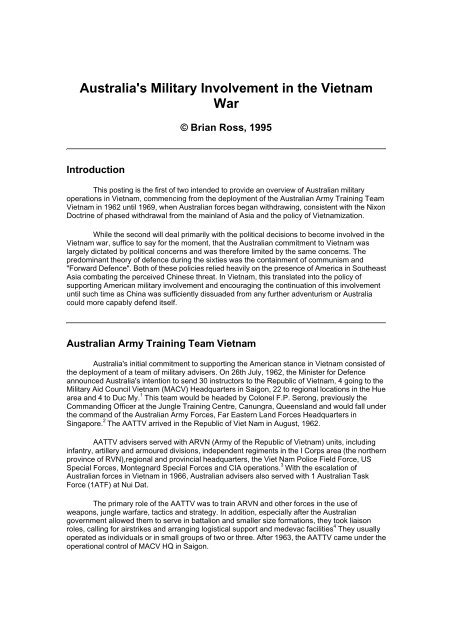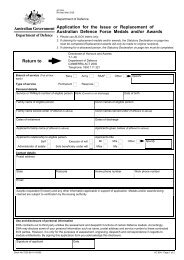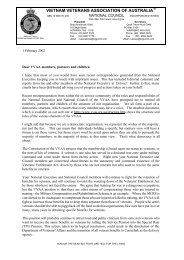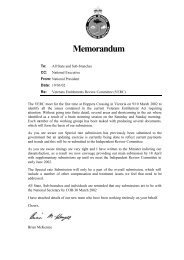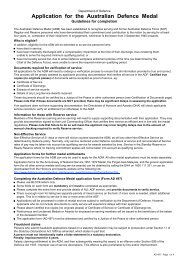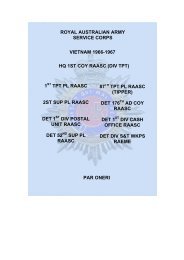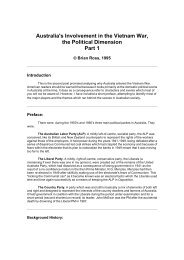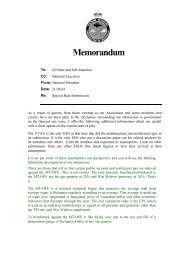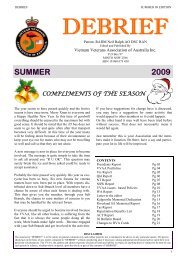Australia's Military Involvement in the Vietnam War - Brian Ross
Australia's Military Involvement in the Vietnam War - Brian Ross
Australia's Military Involvement in the Vietnam War - Brian Ross
You also want an ePaper? Increase the reach of your titles
YUMPU automatically turns print PDFs into web optimized ePapers that Google loves.
<strong>Australia's</strong> <strong>Military</strong> <strong>Involvement</strong> <strong>in</strong> <strong>the</strong> <strong>Vietnam</strong><br />
<strong>War</strong><br />
© <strong>Brian</strong> <strong>Ross</strong>, 1995<br />
Introduction<br />
This post<strong>in</strong>g is <strong>the</strong> first of two <strong>in</strong>tended to provide an overview of Australian military<br />
operations <strong>in</strong> <strong>Vietnam</strong>, commenc<strong>in</strong>g from <strong>the</strong> deployment of <strong>the</strong> Australian Army Tra<strong>in</strong><strong>in</strong>g Team<br />
<strong>Vietnam</strong> <strong>in</strong> 1962 until 1969, when Australian forces began withdraw<strong>in</strong>g, consistent with <strong>the</strong> Nixon<br />
Doctr<strong>in</strong>e of phased withdrawal from <strong>the</strong> ma<strong>in</strong>land of Asia and <strong>the</strong> policy of <strong>Vietnam</strong>ization.<br />
While <strong>the</strong> second will deal primarily with <strong>the</strong> political decisions to become <strong>in</strong>volved <strong>in</strong> <strong>the</strong><br />
<strong>Vietnam</strong> war, suffice to say for <strong>the</strong> moment, that <strong>the</strong> Australian commitment to <strong>Vietnam</strong> was<br />
largely dictated by political concerns and was <strong>the</strong>refore limited by <strong>the</strong> same concerns. The<br />
predom<strong>in</strong>ant <strong>the</strong>ory of defence dur<strong>in</strong>g <strong>the</strong> sixties was <strong>the</strong> conta<strong>in</strong>ment of communism and<br />
"Forward Defence". Both of <strong>the</strong>se policies relied heavily on <strong>the</strong> presence of America <strong>in</strong> Sou<strong>the</strong>ast<br />
Asia combat<strong>in</strong>g <strong>the</strong> perceived Ch<strong>in</strong>ese threat. In <strong>Vietnam</strong>, this translated <strong>in</strong>to <strong>the</strong> policy of<br />
support<strong>in</strong>g American military <strong>in</strong>volvement and encourag<strong>in</strong>g <strong>the</strong> cont<strong>in</strong>uation of this <strong>in</strong>volvement<br />
until such time as Ch<strong>in</strong>a was sufficiently dissuaded from any fur<strong>the</strong>r adventurism or Australia<br />
could more capably defend itself.<br />
Australian Army Tra<strong>in</strong><strong>in</strong>g Team <strong>Vietnam</strong><br />
<strong>Australia's</strong> <strong>in</strong>itial commitment to support<strong>in</strong>g <strong>the</strong> American stance <strong>in</strong> <strong>Vietnam</strong> consisted of<br />
<strong>the</strong> deployment of a team of military advisers. On 26th July, 1962, <strong>the</strong> M<strong>in</strong>ister for Defence<br />
announced <strong>Australia's</strong> <strong>in</strong>tention to send 30 <strong>in</strong>structors to <strong>the</strong> Republic of <strong>Vietnam</strong>, 4 go<strong>in</strong>g to <strong>the</strong><br />
<strong>Military</strong> Aid Council <strong>Vietnam</strong> (MACV) Headquarters <strong>in</strong> Saigon, 22 to regional locations <strong>in</strong> <strong>the</strong> Hue<br />
area and 4 to Duc My. 1 This team would be headed by Colonel F.P. Serong, previously <strong>the</strong><br />
Command<strong>in</strong>g Officer at <strong>the</strong> Jungle Tra<strong>in</strong><strong>in</strong>g Centre, Canungra, Queensland and would fall under<br />
<strong>the</strong> command of <strong>the</strong> Australian Army Forces, Far Eastern Land Forces Headquarters <strong>in</strong><br />
S<strong>in</strong>gapore. 2 The AATTV arrived <strong>in</strong> <strong>the</strong> Republic of Viet Nam <strong>in</strong> August, 1962.<br />
AATTV advisers served with ARVN (Army of <strong>the</strong> Republic of <strong>Vietnam</strong>) units, <strong>in</strong>clud<strong>in</strong>g<br />
<strong>in</strong>fantry, artillery and armoured divisions, <strong>in</strong>dependent regiments <strong>in</strong> <strong>the</strong> I Corps area (<strong>the</strong> nor<strong>the</strong>rn<br />
prov<strong>in</strong>ce of RVN),regional and prov<strong>in</strong>cial headquarters, <strong>the</strong> Viet Nam Police Field Force, US<br />
Special Forces, Montegnard Special Forces and CIA operations. 3 With <strong>the</strong> escalation of<br />
Australian forces <strong>in</strong> <strong>Vietnam</strong> <strong>in</strong> 1966, Australian advisers also served with 1 Australian Task<br />
Force (1ATF) at Nui Dat.<br />
The primary role of <strong>the</strong> AATTV was to tra<strong>in</strong> ARVN and o<strong>the</strong>r forces <strong>in</strong> <strong>the</strong> use of<br />
weapons, jungle warfare, tactics and strategy. In addition, especially after <strong>the</strong> Australian<br />
government allowed <strong>the</strong>m to serve <strong>in</strong> battalion and smaller size formations, <strong>the</strong>y took liaison<br />
roles, call<strong>in</strong>g for airstrikes and arrang<strong>in</strong>g logistical support and medevac facilities 4 They usually<br />
operated as <strong>in</strong>dividuals or <strong>in</strong> small groups of two or three. After 1963, <strong>the</strong> AATTV came under <strong>the</strong><br />
operational control of MACV HQ <strong>in</strong> Saigon.
It was <strong>in</strong>tended that <strong>the</strong> AATTV would represent <strong>Australia's</strong> commitment to <strong>the</strong> American<br />
operations <strong>in</strong> <strong>Vietnam</strong>, and as such, would not have a significant military impact, however, <strong>the</strong><br />
success of Australian advisers, not <strong>the</strong> least Capta<strong>in</strong> Peterson's tra<strong>in</strong><strong>in</strong>g of <strong>the</strong> Montegnard<br />
Special Forces <strong>in</strong> Dar Lac Prov<strong>in</strong>ce, became quickly known throughout <strong>Vietnam</strong>. Peterson<br />
established Armed Propaganda and Intelligence Teams (APIT) from amongst Montegnard<br />
tribesmen <strong>in</strong> Ban Me Thout, designed to dissem<strong>in</strong>ate propaganda, collect <strong>in</strong>formation and<br />
establish a network of <strong>in</strong>formers, disrupt Viet Cong <strong>in</strong>filtration and supply routes, conduct small<br />
scale raids, ambushes and similar m<strong>in</strong>or operations and to conduct long range patrols <strong>in</strong>to Viet<br />
Cong 'safe areas', rescu<strong>in</strong>g captured Montegnards and liberat<strong>in</strong>g equipment and ammunition. 5<br />
Build<strong>in</strong>g on <strong>the</strong>se ga<strong>in</strong>s, Peterson established a 'People's Army' just prior to his departure, which<br />
at that stage had effectively rega<strong>in</strong>ed control over much of sou<strong>the</strong>rn Dar Lac. Despite <strong>the</strong><br />
<strong>in</strong>adequacies of <strong>the</strong> ARVN forces <strong>in</strong> protect<strong>in</strong>g pacified areas, and <strong>the</strong> racial problems between<br />
Montegnards and ARVN personnel, Peterson had succeeded <strong>in</strong> rega<strong>in</strong><strong>in</strong>g <strong>the</strong> upper hand <strong>in</strong> <strong>the</strong><br />
Ban Me Thout region.<br />
AATTV techniques and method of operations were significantly different to many of those<br />
employed by <strong>the</strong>ir American allies. Experience <strong>in</strong> <strong>the</strong> jungles of Malaya and Borneo and<br />
limitations on <strong>the</strong> number of and facilities available to personnel had comb<strong>in</strong>ed to produce very<br />
different tactics. Whilst American <strong>in</strong>structors expounded <strong>the</strong> virtues of <strong>the</strong> rapid deployment of<br />
large numbers of troops, massive fire power and decisive battles, Australians concentrated on<br />
<strong>in</strong>dividual marksmanship, <strong>the</strong> <strong>in</strong>dependence of platoons from battalion HQs, small scale patrols<br />
and ambushes. These differences frequently bought Australian advisers <strong>in</strong>to conflict with <strong>the</strong>ir<br />
American superiors. The Australian policy of 'economy of effort' was directly opposed to <strong>the</strong><br />
American idea of 'concentration of force'. 6<br />
The AATTV served with dist<strong>in</strong>ction <strong>in</strong> <strong>Vietnam</strong>. Dur<strong>in</strong>g AATTV's tour of duty, members<br />
were awarded two [sic] Victoria Crosses, several <strong>Military</strong> Crosses and several <strong>Military</strong> Medals. 7 It<br />
was <strong>the</strong> first Australian force to arrive and <strong>the</strong> last to leave. After <strong>the</strong> <strong>in</strong>itial deployment of 30<br />
<strong>in</strong>structors, it was <strong>in</strong>creased <strong>in</strong> size by 30 <strong>in</strong> May 64, by 23 <strong>in</strong> June 64 and <strong>the</strong>n by 17 <strong>in</strong> January<br />
65, br<strong>in</strong>g<strong>in</strong>g it to a total strength of 100. It was restricted from fur<strong>the</strong>r <strong>in</strong>creases by <strong>the</strong> <strong>in</strong>troduction<br />
of a National Service Act (1965) <strong>in</strong> Australia which required large numbers of <strong>in</strong>structors. The last<br />
<strong>in</strong>structors were withdrawn from Phuoc Tuy Prov<strong>in</strong>ce <strong>in</strong> December 1972.<br />
The First Deployment of Australian Ground Forces<br />
In April 1965, consistent with President Johnson's deployment of US Mar<strong>in</strong>es to protect<br />
airforce bases <strong>in</strong> <strong>Vietnam</strong>, Prime M<strong>in</strong>ister Robert Menzies announced his <strong>in</strong>tention to send 1<br />
Battalion, Royal Australian Regiment (1 RAR) to assist <strong>in</strong> <strong>the</strong> defence of American bases. 1 RAR<br />
was restructured <strong>in</strong>to a tropic warfare organisation, similar to that employed by <strong>the</strong> American<br />
army and was to serve under <strong>the</strong> US 173 rd Airborne Brigade (Separate) (US 173 Abn<br />
Bde)defend<strong>in</strong>g Bien Hoa airforce base. 8 Initially it was <strong>in</strong>tended that 1 RAR would only be used <strong>in</strong><br />
defence of <strong>the</strong> base but by December offensive operations had begun <strong>in</strong> conjunction with 173<br />
Abn Bde. 9 Dur<strong>in</strong>g 1 RAR's tour of duty, 22 major operations were conducted, usually with<strong>in</strong> 10-20<br />
miles from Bien Hoa.<br />
Like <strong>the</strong> AATTV, significant problems were encountered <strong>in</strong> operat<strong>in</strong>g with US forces.<br />
These were compounded by poor equipment, <strong>in</strong>clud<strong>in</strong>g WWII Owen mach<strong>in</strong>e guns and boots,<br />
and no decent preparation before embarkation. 10 The operational problems <strong>the</strong>y encountered will<br />
be discussed below, suffice to say here that <strong>the</strong>y were not sufficiently resolved until 1 ATF was<br />
established with its relative <strong>in</strong>dependence. Despite <strong>the</strong>se limitations, however, <strong>the</strong> Australian<br />
regiment was successfully <strong>in</strong>tegrated <strong>in</strong>to <strong>the</strong> 173rd Abn Bde until it's tour of duty was completed<br />
<strong>in</strong> June 1966.
1 Australian Task Force, Phuoc Tuy Prov<strong>in</strong>ce<br />
In March 1966, <strong>the</strong> Australian government announced its <strong>in</strong>tention to create a s<strong>in</strong>gle and<br />
relatively <strong>in</strong>dependent Australian Task Force. This came largely as a result of political pressure<br />
on <strong>the</strong> Australian government by Wash<strong>in</strong>gton but was also consistent with <strong>the</strong> dom<strong>in</strong>ant foreign<br />
and defence policy trends with<strong>in</strong> Canberra at <strong>the</strong> time. However, <strong>the</strong>re was good reason to create<br />
<strong>the</strong> Task Force from a military po<strong>in</strong>t of view also. Not only would Australians rega<strong>in</strong> some control<br />
over <strong>the</strong>ir troops, <strong>the</strong>y would also be permitted to conduct operations <strong>in</strong> a manner consistent with<br />
<strong>the</strong>ir experiences and techniques. Consideration was also given to <strong>the</strong> limited resources available<br />
to <strong>the</strong> Australian command <strong>in</strong> <strong>Vietnam</strong> and <strong>the</strong> need to pool <strong>the</strong>se <strong>in</strong> order to have a more visible<br />
effect.<br />
Phuoc Tuy Prov<strong>in</strong>ce was situated <strong>in</strong> III Corps Tactical Zone and had a population of<br />
160,000. At <strong>the</strong> time <strong>the</strong> Australian Task Force arrived, it was a relatively wealthy prov<strong>in</strong>ce,<br />
agriculturally rich and had a comparatively prosperous coastal economy. 11 It had been a base for<br />
anti-French activities after WWII and was familiar with <strong>the</strong> Viet M<strong>in</strong>h presence that accompanied<br />
<strong>the</strong>se activities. Despite hav<strong>in</strong>g two large Catholic migrant towns, it was also a popular base for<br />
Viet Cong activities throughout <strong>the</strong> period of Diem's authority. 12 Operational <strong>in</strong> Phuoc Tuy were<br />
<strong>the</strong> 274th and 275th NLF Regiments and D445 Prov<strong>in</strong>cial Mobile Battalion, a local force with<br />
strong l<strong>in</strong>ks to <strong>the</strong> population, an <strong>in</strong>timate knowledge of <strong>the</strong> area and assured supplies 13<br />
Phuoc Tuy was chosen because <strong>the</strong>re was a reasonable amount of enemy activity, no<br />
risk of border violations <strong>in</strong> <strong>the</strong> pursuit of <strong>the</strong> enemy and it had excellent air and sea access<br />
ensur<strong>in</strong>g adequate supplies and an assured evacuation route. The terra<strong>in</strong> was not dissimilar from<br />
that often encountered by Australians <strong>in</strong> Malaya and Borneo. 14 In addition to this, <strong>the</strong> pacification<br />
of Phuoc Tuy was essential to <strong>the</strong> Republic of Viet Nam because of it's wealth and to <strong>the</strong> MACV<br />
because of <strong>the</strong> significance of Vung Tau port and <strong>the</strong> supply l<strong>in</strong>e (Route 15) to Saigon and Bien<br />
Hoa.<br />
The exact placement of <strong>the</strong> Task Force was to be Nui Dat, a hill on Route 2, head<strong>in</strong>g<br />
north through <strong>the</strong> centre of <strong>the</strong> prov<strong>in</strong>ce, and was an obvious challenge to <strong>the</strong> NLF and NVA<br />
forces <strong>in</strong> <strong>the</strong> area. The Logistics and Supply Group (1 ALSG) was to be situated <strong>in</strong> Vung Tau<br />
where it had good access to American supply groups and where it was hoped that it would be<br />
somewhat safer from large scale attack. 15<br />
The Task Force was to be comprised of 2 <strong>in</strong>fantry battalions (5/6 RAR were <strong>the</strong> first to<br />
serve <strong>in</strong> 1ATF), artillery (<strong>in</strong>clud<strong>in</strong>g some New Zealand elements), eng<strong>in</strong>eers, signals and<br />
adm<strong>in</strong>istrative support, under <strong>the</strong> command of Brigadier O.D. Jackson. 1 ALSG, situated <strong>in</strong> Vung<br />
Tau, consisted of 176 Air Dispatch Company, 2 Field Ambulance, 33 Dental Unit, 2 Composite<br />
Ordnance Depot and <strong>the</strong> 101 Field Workshop of Royal Australian Electrical and Mechanical<br />
Eng<strong>in</strong>eers. 16 S<strong>in</strong>ce August 1964, No.35 Transport Squadron R AAF had been situated at Vung<br />
Tau and one year after <strong>the</strong> arrival of 1 ALSG, (June 1966) No.9 Helicopter Squadron was also<br />
situated <strong>in</strong> Phuoc Tuy. 17<br />
1 ATF's objectives <strong>in</strong> Phuoc Tuy were never very clear. Because it came under <strong>the</strong><br />
operational command of US II Field Forces <strong>Vietnam</strong> (II FFV) but under <strong>the</strong> National command of<br />
Headquarters Australian Forces <strong>Vietnam</strong>, <strong>the</strong> Commander 1 ATF had to reconcile sometimes<br />
<strong>in</strong>consistent objectives. Westmoreland told Jackson to "take over Phuoc Tuy" 18 this represent<strong>in</strong>g<br />
<strong>the</strong> sum of operational commands to 1 ATF whilst from COMAFV, directions were only a little<br />
more specific. The aims of 1 ATF were def<strong>in</strong>ed as <strong>the</strong> security and dom<strong>in</strong>ation of 1 ATF's<br />
assigned area, <strong>the</strong> security of Route 15, <strong>the</strong> conduct of o<strong>the</strong>r operations as required, conduct<br />
operations anywhere <strong>in</strong> II Corps Tactical Zone and <strong>in</strong> B<strong>in</strong> Thuan Prov<strong>in</strong>ce, II Corps Tactical Zone,
as required and agreed up on by COMAFV. 19 The actual practicality of <strong>the</strong>se aims was hard to<br />
assess but it seems that this meant 1 ATF was to act <strong>in</strong> both a pacification role as well as a large<br />
unit to counter ma<strong>in</strong> force activity. COIN operations would require frequent contact and close<br />
coord<strong>in</strong>ation with ARVN forces and <strong>the</strong> civilian adm<strong>in</strong>istration, yet <strong>the</strong> advisory positions <strong>in</strong> ARVN<br />
and <strong>the</strong> adm<strong>in</strong>istration were dom<strong>in</strong>ated by Americans. Alternatively, large scale operations<br />
aga<strong>in</strong>st ma<strong>in</strong> force units required more manpower, mobility and fire support and could not<br />
adequately be completed by two battalions, one of which would be required for base security at<br />
all times. 20<br />
This obscurity when it came to <strong>the</strong> nature of operations 1 ATF was to engage <strong>in</strong> did<br />
provide <strong>the</strong> Commander with some degree of operational freedom. It was not long before <strong>the</strong><br />
Australian forces had applied <strong>the</strong>ir own style of operation. The base at Nui Dat, whilst its<br />
presence was readily felt <strong>in</strong> <strong>the</strong> area, was not cleared as were American bases and few ARVN<br />
personnel and no <strong>in</strong>digenous <strong>Vietnam</strong>ese were allowed <strong>in</strong> to <strong>the</strong> base. This meant that troop<br />
strength at any one time was hard to gauge and security was excellent. 21<br />
It was D Company of 6 RAR that first encountered <strong>the</strong> enemy <strong>in</strong> strength at Long Tan on<br />
<strong>the</strong> 18th August, 1966. In engag<strong>in</strong>g and severely damag<strong>in</strong>g D445 Regiment, 1 ATF had<br />
established a moral and later physical victory over <strong>the</strong> NLF <strong>in</strong> Phuoc Tuy. The TET offensive of<br />
February 1968 also contributed to <strong>the</strong> relative demise of <strong>the</strong> VC 5 th Division (274 and 275<br />
Regiments) <strong>in</strong> <strong>the</strong> region, due to <strong>the</strong> heavy casualties <strong>the</strong>y took. In order to combat <strong>the</strong><br />
decreas<strong>in</strong>g strengths of <strong>the</strong> pre-exist<strong>in</strong>g NLF forces <strong>in</strong> <strong>the</strong> prov<strong>in</strong>ce D440 was created <strong>in</strong> 1967,<br />
however, this too proved relatively <strong>in</strong>effective, not be<strong>in</strong>g a local force so much as compris<strong>in</strong>g<br />
large numbers of NVA personnel. 22<br />
In November 1967, 1 ATF was <strong>in</strong>creased <strong>in</strong> size by an extra battalion (<strong>in</strong>clud<strong>in</strong>g of NZ<br />
artillery) and was re<strong>in</strong>forced by a squadron of Centurion tanks. This was largely <strong>in</strong> response to<br />
<strong>the</strong> deteriorat<strong>in</strong>g military situation <strong>in</strong> <strong>Vietnam</strong> and <strong>the</strong> possibility of a TET offensive. General<br />
V<strong>in</strong>cent (COMAFV, Jan. 67 to Jan. 68) was enthusiastic to <strong>in</strong>crease Australian forces ei<strong>the</strong>r to<br />
enable <strong>the</strong>m to take responsibility for all of Phuoc Tuy or alternatively to allow 1 ATF to operate<br />
more tangibly outside Phuoc Tuy Prov<strong>in</strong>ce. 23 As a result, <strong>in</strong> January 1968, 1 ATF was ordered to<br />
occupy an area 12 km north of Bien Hoa airforce base with a view to prevent<strong>in</strong>g any expected<br />
TET assault. 1 ATF successfully engaged and defeated <strong>the</strong> enemy <strong>in</strong> February (as it did an<br />
offensive <strong>in</strong> Baria at <strong>the</strong> same time) and returned to Nui Dat. It was aga<strong>in</strong> called on to help defend<br />
Bien Hoa <strong>in</strong> May. 24<br />
If V<strong>in</strong>cent was enthusiastic about <strong>Australia's</strong> role <strong>in</strong> <strong>the</strong> war, <strong>the</strong>n McDonald, his<br />
successor, was passionate. McDonald was keen not to see Australian operations limited to<br />
"[sav<strong>in</strong>g] <strong>the</strong> odd house from be<strong>in</strong>g burned to <strong>the</strong> ground" <strong>in</strong> Phuoc Tuy. In ga<strong>in</strong><strong>in</strong>g U S support<br />
for operations aga<strong>in</strong>st <strong>the</strong> VC <strong>in</strong> <strong>the</strong> Long Hai Hills <strong>in</strong> March 1968, McDonald believed <strong>the</strong> US was<br />
attempt<strong>in</strong>g to hasten <strong>Australia's</strong> victory over <strong>the</strong> enemy <strong>in</strong> Phuoc Tuy so as to get 1 ATF<br />
operational <strong>in</strong> areas of more strategic importance. 25<br />
By 1969 and <strong>the</strong> beg<strong>in</strong>n<strong>in</strong>g of <strong>the</strong> US withdrawal from South <strong>Vietnam</strong>, II FFV had reprioritized<br />
its aims and <strong>in</strong>structed <strong>the</strong> <strong>the</strong>n COMAEV, General Hay, that 1 ATF should do likewise.<br />
First priority was to be given to pacification, second to upgrad<strong>in</strong>g ARVN forces and thirdly to<br />
military operations. Pacification operations began <strong>in</strong> May 1969 however, hampered by<br />
unenthusiastic ARVN forces, <strong>the</strong>y proceeded slowly. The success of <strong>the</strong> ATF <strong>in</strong> forc<strong>in</strong>g <strong>the</strong><br />
withdrawal of NLF ma<strong>in</strong>force units and <strong>the</strong> prov<strong>in</strong>cial battalions (<strong>the</strong> remnants of D445 and <strong>the</strong><br />
newer but understrength D440) was countered by <strong>the</strong> ma<strong>in</strong>tenance of <strong>the</strong> VC <strong>in</strong>frastructure <strong>in</strong> <strong>the</strong><br />
villages. 26 Thus, as <strong>the</strong> Task Force withdrew <strong>in</strong> December 1971, <strong>the</strong> rema<strong>in</strong><strong>in</strong>g AATTV members<br />
presided over <strong>the</strong> gradual return of NLF <strong>in</strong> Phuoc Tuy.
The Royal Australian Navy (RAN) and Royal Australian Air Force<br />
(RAAF) <strong>in</strong> <strong>Vietnam</strong><br />
As part of <strong>the</strong> policy of encourag<strong>in</strong>g American <strong>in</strong>volvement <strong>in</strong> <strong>Vietnam</strong>, and as a result of<br />
his conv<strong>in</strong>c<strong>in</strong>g victory at <strong>the</strong> polls <strong>in</strong> November 1966, Menzies decided to <strong>in</strong>crease <strong>Australia's</strong><br />
military commitment to <strong>Vietnam</strong> to <strong>in</strong>clude elements of all three services. The commission<strong>in</strong>g of<br />
two Charles F. Adams guided missile destroyers <strong>in</strong> 1965 and <strong>the</strong> impend<strong>in</strong>g replacement of<br />
Canberra bombers by F-111s had made available to COMAFV additional sources for Australian<br />
expansion <strong>in</strong> <strong>Vietnam</strong>. 27<br />
RAAF:<br />
S<strong>in</strong>ce August 1964, elements of No.35 Squadron (Transport) consist<strong>in</strong>g of fixed w<strong>in</strong>g<br />
Caribous, had been stationed at Vung Tau <strong>in</strong> order to assist <strong>in</strong> <strong>the</strong> movement and supply of 1<br />
RAR. With <strong>the</strong> establishment of 1ATF and 1 ALSG <strong>in</strong> June 1966, No.9 Squadron (Helicopters)<br />
were deployed to provide logistic support, troop movement and medevac facilities for <strong>the</strong> Task<br />
Force. Both of <strong>the</strong>se commitments were relatively <strong>in</strong>significant except <strong>in</strong> so far as <strong>the</strong>y represent<br />
a desire to have Australians support<strong>in</strong>g Australians <strong>in</strong> Phuoc Tuy. Both units served as essential<br />
support for 1 ATF but added little to <strong>the</strong> ongo<strong>in</strong>g American <strong>in</strong>volvement.<br />
Perhaps one of <strong>the</strong> most significant RAAF contributions to <strong>the</strong> <strong>Vietnam</strong> war was <strong>the</strong><br />
deployment of No.2 Squadron (Canberra Bombers) to Phan Rang <strong>in</strong> April 1967. The Australian<br />
5th Airfield Construction Squadron had completed <strong>the</strong> provision of Australian facilities by <strong>the</strong> time<br />
<strong>the</strong> first eight of ten bombers arrived. The bombers were to undergo usual ma<strong>in</strong>tenance <strong>in</strong> Phan<br />
Rang but had additional facilities at Butterworth, <strong>in</strong> Malaysia for major ma<strong>in</strong>tenance. 28 The entire<br />
cont<strong>in</strong>gent consisted of approximately 300 men and came under <strong>the</strong> command of USAF 35th<br />
Tactical Fighter W<strong>in</strong>g. 29<br />
At <strong>the</strong> height of <strong>Australia's</strong> military <strong>in</strong>volvement <strong>in</strong> <strong>Vietnam</strong>, RAAF personnel numbered<br />
around 800 people from three squadrons. The Canberra Bomber squadron was <strong>the</strong> first<br />
summoned home <strong>in</strong> March 1971 followed by <strong>the</strong> rema<strong>in</strong><strong>in</strong>g RAAF personnel <strong>in</strong> August.<br />
RAN:<br />
The Royal Australian Navy's cont<strong>in</strong>gent to <strong>the</strong> <strong>Vietnam</strong> war was somewhat more<br />
substantial. The first RAN personnel to see action were <strong>the</strong> six members of Clearance Div<strong>in</strong>g<br />
Team 3. CDT 3 was <strong>in</strong>itially part of <strong>the</strong> Inshore Undersea <strong>War</strong>fare Group 1, based at Cam Ranh<br />
Bay but itself was assigned to Vung Tau from February 1967. It was largely responsible for<br />
assist<strong>in</strong>g <strong>in</strong> harbour defence, Explosive Ordnance Disposal (EOD), harbour patrols and port<br />
command and communications dur<strong>in</strong>g Operation Stabledoor (1967-1970). 30 In addition to <strong>the</strong>se<br />
responsibilities, CDT 3 was called on to conduct mar<strong>in</strong>e salvage operations, especially where<br />
EOD might be called for, river clear<strong>in</strong>g <strong>in</strong> preparation for river<strong>in</strong>e military operations and recovery<br />
of enemy ammunition.<br />
The largest RAN contribution however was supplied by <strong>the</strong> deployment of Australian<br />
destroyers to <strong>Vietnam</strong>. The destroyers came under <strong>the</strong> command of COMNAVFORV, primarily<br />
operat<strong>in</strong>g with <strong>the</strong> US Seventh meet and <strong>in</strong> March 1967, HMAS Hobart, was <strong>the</strong> first to see<br />
action. 31 HMA Ships Hobart and Perth alternated sixth month deployments until March 1969<br />
when <strong>Australia's</strong> newest DDG, HMAS Brisbane arrived. Brisbane was replaced by Vendetta, a<br />
Dar<strong>in</strong>g Class Destroyer which was <strong>in</strong> turn replaced by Perth and Hobart respectively before<br />
complet<strong>in</strong>g RAN participation <strong>in</strong> <strong>the</strong> <strong>Vietnam</strong> conflict. 32 Hobart, be<strong>in</strong>g <strong>the</strong> first RAN vessel to arrive<br />
<strong>in</strong> <strong>Vietnam</strong> under combat conditions, participated <strong>in</strong> Operation Roll<strong>in</strong>g Thunder's maritime<br />
equivalent, Operation Sea Dragon. This was designed primarily to <strong>in</strong>tercept Water Borne Logistic
Craft (WBLC) and bomb military and logistic targets north of <strong>the</strong> DMZ. Sea Dragon was<br />
suspended <strong>in</strong> November 1968 dur<strong>in</strong>g Perth's second deployment. After this, RAN vessels'<br />
primary task was to provide Naval Gunfire Support (NGFS) for ground operations near <strong>the</strong> coast.<br />
Whilst <strong>the</strong> threat of naval or air assault on Australian vessels was not very large 33 , as was<br />
<strong>the</strong> threat of sea borne m<strong>in</strong>es. However, dur<strong>in</strong>g <strong>in</strong>shore operations aga<strong>in</strong>st WBLCs and <strong>in</strong> support<br />
of amphibious assaults, <strong>the</strong> ships were somewhat exposed to ground fire. In September 1967<br />
Perth was hit by fire from a shore battery whilst <strong>in</strong> <strong>the</strong> pursuit of WBLC. Australian vessels were<br />
also used <strong>in</strong> conjunction with 1 ATF <strong>in</strong> Phuoc Tuy. In May 1970 Hobart relieved USS St Paul and<br />
provided NGFS for Australian troops <strong>in</strong> <strong>the</strong> Long Hai Hills. 34<br />
The Royal Australian Navy also played a considerable role <strong>in</strong> <strong>the</strong> deployment of<br />
Australian troops and supply to 1 ATF and RAN vessels <strong>in</strong> <strong>the</strong> Gulf of Tonk<strong>in</strong>. Primary amongst<br />
<strong>the</strong>se was HMAS Sydney, an aircraft carrier converted <strong>in</strong>to a troop transport. 1 RAR was<br />
despatched aboard HMAS Sydney from Sydney to Vung Tau <strong>in</strong> May 1965. HMA Ships Jeparit<br />
and Boonaroo acted as supply ships for Australian forces <strong>in</strong> <strong>Vietnam</strong> and were particularly<br />
important <strong>in</strong> supply<strong>in</strong>g HMAS Vendetta with ammunition dur<strong>in</strong>g its deployment. 35<br />
O<strong>the</strong>r aspects of RAN <strong>in</strong>volvement <strong>in</strong> <strong>Vietnam</strong> <strong>in</strong>cluded <strong>the</strong> dispatch of 8 pilots and<br />
support staff for retra<strong>in</strong><strong>in</strong>g and post<strong>in</strong>g with US 135th Aviation Company at Vung Tau <strong>in</strong> October<br />
1967. The RAN Helicopter Flight <strong>Vietnam</strong> (RANHFV) was used for troop <strong>in</strong>sertion and as<br />
gunships for support fire. The RAN also provided pilots as part of a detachment to No.9 Squadron<br />
RAAF at Nui Dat, operat<strong>in</strong>g <strong>in</strong> cooperation with 1 ATF. 36<br />
The Royal Australian Navy personnel <strong>in</strong> <strong>Vietnam</strong> totalled 2800. As far as possible RAN<br />
forces were directed to operate <strong>in</strong> cooperation with 1 ATF <strong>in</strong> Phuoc Tuy Prov<strong>in</strong>ce, consistent with<br />
<strong>the</strong> concept of hav<strong>in</strong>g an Australian sphere of <strong>in</strong>fluence. Whilst operational command was<br />
reserved for COMNAVFORV, <strong>the</strong> degree of <strong>in</strong>tegration with Australian forces was ma<strong>in</strong>ta<strong>in</strong>ed<br />
until <strong>the</strong> last RAN vessel, HMAS Sydney departed from Vung Tau <strong>in</strong> February 1972.<br />
Assessment of Australian <strong>Military</strong> Operations<br />
AATTV: Quite obviously if <strong>the</strong> general method of operations practiced by Australian forces was<br />
significantly different to those employed by US forces, <strong>the</strong>n so to would <strong>the</strong> tra<strong>in</strong><strong>in</strong>g techniques.<br />
The AATTV, <strong>in</strong> <strong>in</strong>struct<strong>in</strong>g <strong>Vietnam</strong>ese officers, often found <strong>the</strong>mselves contradict<strong>in</strong>g or be<strong>in</strong>g<br />
contradicted by US advisers. In addition to this, such was <strong>the</strong> social status acquired by be<strong>in</strong>g an<br />
officer <strong>in</strong> ARVN that Junior officers were discouraged from humiliat<strong>in</strong>g <strong>the</strong>ir seniors by learn<strong>in</strong>g<br />
more than <strong>the</strong>y. Particularly if one tra<strong>in</strong>ed junior officer was expected to serve under an untra<strong>in</strong>ed<br />
(by AATTV or o<strong>the</strong>rs) senior officer. 37 AATTV advisers serv<strong>in</strong>g with Montegnard units found that<br />
ethnic rivalry between Montegnards and <strong>the</strong> <strong>Vietnam</strong>ese often resulted <strong>in</strong> 'no shoot' agreements<br />
be<strong>in</strong>g made with <strong>the</strong> NLF and VC forces enter<strong>in</strong>g <strong>Vietnam</strong> via Laos or Cambodia. Peterson's<br />
Montegnard Special Forces at one stage <strong>in</strong> 1964 even rebelled, march<strong>in</strong>g on ARVN forces <strong>in</strong> Ban<br />
Me Thout. 38<br />
AATTV operations under COMMACV were quite successful. There were few problems <strong>in</strong><br />
<strong>the</strong> actual command system, save that <strong>the</strong>re were disagreements over methodology when it<br />
came to <strong>in</strong>struction. AATTV's only real problems came from work<strong>in</strong>g with <strong>the</strong> ARVN forces, whom<br />
<strong>the</strong>y frequently found to be unenthusiastic, lazy and often corrupt.<br />
1 RAR and US 173rd Abn Bde:There were aga<strong>in</strong> general differences of op<strong>in</strong>ion between <strong>the</strong>se<br />
two units as to <strong>the</strong> conduct of operations. The Airborne Brigade was designed for large
deployments and heavy firepower whereas 1 RAR, even though restructured to suit <strong>the</strong> American<br />
style, with its COIN experience <strong>in</strong> Malaya operat<strong>in</strong>g <strong>in</strong>dividually from larger units was unfamiliar<br />
and uncomfortable with <strong>the</strong>se type of tactics. 39 One such example of this was 1 RAR's tra<strong>in</strong><strong>in</strong>g<br />
with helicopters. In Malaya, up to 4 helicopters, primarily for medevac purposes, was all a<br />
company could expect or need. There was no requirement for <strong>the</strong> call<strong>in</strong>g of air strikes and little for<br />
artillery strikes. Yet at Bien Hoa, <strong>the</strong> latter of <strong>the</strong>se two were frequently practiced, due to <strong>the</strong><br />
number of enemy be<strong>in</strong>g engaged, and up to 40 helicopters were effectively at <strong>the</strong> disposal of <strong>the</strong><br />
battalion. 40 Unlike subsequent Australian forces, <strong>the</strong>re was little association with ARVN forces<br />
and no reliance on <strong>the</strong>m.<br />
Australian Task Force:1ATF met with mixed successes dur<strong>in</strong>g its five years <strong>in</strong> Phuoc Tuy.<br />
Initially, 5 & 6 RAR encountered large scale opposition and attempted to combat NLF political<br />
structure. Given <strong>the</strong> limitations under which 1 ATF worked (poor equipment, ambiguous<br />
objectives and unfamiliar combat environment), it could be asserted that it was quite successful <strong>in</strong><br />
do<strong>in</strong>g this. 41 Long Tan and <strong>the</strong> subsequent follow up missions severely damaged NLF ma<strong>in</strong> force<br />
units <strong>in</strong> <strong>the</strong> region, however, it is was apparent that <strong>the</strong> relative speed with which <strong>the</strong> NLF<br />
reasserted itself <strong>in</strong> <strong>the</strong> years of ATF's withdrawal <strong>in</strong>dicates <strong>the</strong> failure to w<strong>in</strong> <strong>the</strong> hearts and m<strong>in</strong>ds<br />
of <strong>the</strong> people, a tactic essential to <strong>the</strong> defeat of communist terrorists <strong>in</strong> Malaya and Borneo.<br />
The <strong>in</strong>crease <strong>in</strong> size of 1 ATF <strong>in</strong> November 1967 <strong>in</strong>troduced new problems and new<br />
challenges to <strong>the</strong> Australians. From January, 1 ATF operated <strong>in</strong> engagements outside of Phuoc<br />
Tuy. These were aga<strong>in</strong> large scale operations and required some degree of <strong>in</strong>tegration with<br />
American forces. Similar problems to those experienced by 1 RAR <strong>in</strong> 1965 were encountered,<br />
somewhat lessened <strong>in</strong> effect by <strong>the</strong> larger size of 1 ATF (two battalions were distributed through<br />
three bases; Balmoral, Coogee and Coral) and its <strong>in</strong>creased <strong>in</strong>dependence from II FFV HQ. The<br />
defence of Bien Hoa dur<strong>in</strong>g <strong>the</strong> TET offensive <strong>in</strong> February 1968 was successful <strong>in</strong> so far as 1<br />
ATF ma<strong>in</strong>ta<strong>in</strong>ed a relatively high enemy body count and weren't <strong>the</strong>mselves overrun. However,<br />
<strong>the</strong> nature of <strong>the</strong> war was such that victories <strong>in</strong> large scale battle counted for little. It was hoped<br />
that 1 ATF could secure a credible victory <strong>in</strong> Phuoc Tuy, one similar <strong>in</strong> nature to <strong>Australia's</strong><br />
military experience <strong>in</strong> Malaya, where <strong>the</strong> enemy was totally wiped out, <strong>the</strong> people supportive of<br />
<strong>the</strong> Australian presence and <strong>the</strong> prov<strong>in</strong>ce safe from subversion. ...an effect, a last<strong>in</strong>g and<br />
significant impact on <strong>the</strong> prov<strong>in</strong>ce, culm<strong>in</strong>at<strong>in</strong>g <strong>in</strong> <strong>the</strong> battle of B<strong>in</strong>h Ba <strong>in</strong> June 1969. 1 ATF<br />
returned to Phuoc Tuy, after several redeployments to Bien Hoa, and engaged <strong>in</strong> <strong>the</strong> third phase<br />
of <strong>the</strong>ir operations, <strong>the</strong> pacification of Phuoc Tuy. 42<br />
This phase, from about mid-1969 to 1971, met with mixed success also. Although<br />
carry<strong>in</strong>g out operations which Australian troops were more familiar with, <strong>the</strong> degree of success<br />
encountered was somewhat less than expected. The reasons for this relative failure <strong>in</strong>clude not<br />
only <strong>the</strong> <strong>in</strong>eptitude of ARVN forces, cooperation with whom was essential <strong>in</strong> ma<strong>in</strong>ta<strong>in</strong><strong>in</strong>g an allied<br />
presence <strong>in</strong> any given area, but also several ra<strong>the</strong>r glar<strong>in</strong>g deficiencies <strong>in</strong> Australian plann<strong>in</strong>g. An<br />
ambitious project by V<strong>in</strong>cent <strong>in</strong> 1867 to create a m<strong>in</strong>efield barrier from Dat Do to Phuoc Hai,<br />
described by Westmoreland as "imag<strong>in</strong>ative", had resulted <strong>in</strong> a substantial number of casualties<br />
(almost thirty) <strong>in</strong> operations <strong>in</strong> <strong>the</strong> Long Hai hills <strong>in</strong> May 1969 and aga<strong>in</strong> by 8 RAR <strong>in</strong> January<br />
1970. 43 Whilst it may have been <strong>the</strong> responsibility of ARVN forces to patrol <strong>the</strong> m<strong>in</strong>efield, it was<br />
apparent that V<strong>in</strong>cent was remiss <strong>in</strong> expect<strong>in</strong>g <strong>the</strong>m to do so. In addition to this, Larsen identifies<br />
one major deficiency <strong>in</strong> <strong>the</strong> Australian civil aid program, claim<strong>in</strong>g that lack of coord<strong>in</strong>ation with<br />
local adm<strong>in</strong>istration often resulted <strong>in</strong> poor plann<strong>in</strong>g and <strong>in</strong>adequate ma<strong>in</strong>tenance of completed<br />
projects. 44<br />
Quite clearly <strong>the</strong> major reason for <strong>the</strong> failure of 1 ATF to complete a total victory <strong>in</strong> Phuoc<br />
Tuy was <strong>the</strong> lack of cooperation between ARVN and 1 ATF and <strong>the</strong> failure of <strong>the</strong> civil aid program<br />
to w<strong>in</strong> <strong>the</strong> support of <strong>the</strong> populace away from <strong>the</strong> NLF. <strong>Australia's</strong> attempts to tra<strong>in</strong> and equip<br />
RVN local units and <strong>the</strong>ir reluctance to allow <strong>the</strong>se units any significant participation <strong>in</strong> <strong>the</strong><br />
pacification program, coupled with <strong>the</strong> failure of <strong>the</strong>se local units to perform adequately, dest<strong>in</strong>ed<br />
Phuoc Tuy to be returned to <strong>the</strong> <strong>in</strong>fluence of <strong>the</strong> NLF on <strong>the</strong> ATF's withdrawal.
Conclusion<br />
The Nixon (Guam) Doctr<strong>in</strong>e announced <strong>in</strong> July 1969 and <strong>the</strong> British decision to quit East<br />
Of Suez by 1971 led to a radical reth<strong>in</strong>k<strong>in</strong>g of Australian defence and foreign policy <strong>in</strong> Sou<strong>the</strong>ast<br />
Asia. Consistent with <strong>the</strong> withdrawal of American forces from <strong>Vietnam</strong>, Australia also withdrew,<br />
<strong>the</strong> last Australian troops to leave be<strong>in</strong>g <strong>the</strong> AATTV. The defeat of <strong>the</strong> Liberal-Country Party<br />
coalition government co<strong>in</strong>cided with this f<strong>in</strong>al withdrawal. Australia had spent ten years actively<br />
<strong>in</strong>volved <strong>in</strong> <strong>the</strong> conflict <strong>in</strong> <strong>Vietnam</strong>, send<strong>in</strong>g almost 47 000 [sic] men, almost 500 of whom were<br />
killed and about 2 400 wounded. Australia paid its own way through <strong>Vietnam</strong>, employed its own<br />
tactical methods, adopted its own prov<strong>in</strong>ce and pursued its own political ends. Australian's were<br />
noted to have hated everybody, <strong>the</strong> truth of which may lay under a mixture of racial prejudice and<br />
discontent at <strong>the</strong> limitations <strong>the</strong>y were placed under compared to <strong>the</strong> excesses of <strong>the</strong>ir American<br />
allies.<br />
Endnotes<br />
1. p.8, <strong>Australia's</strong> <strong>Military</strong> Committment to <strong>Vietnam</strong>, Paper tabled <strong>in</strong> accordance with <strong>the</strong><br />
Prime M<strong>in</strong>ister's Statement <strong>in</strong> <strong>the</strong> House of Representatives on 13 May 1975.<br />
2. p.1, Horner, D.M., Australian Higher Command <strong>in</strong> <strong>the</strong> <strong>Vietnam</strong> <strong>War</strong>, Canberra Papers on<br />
Strategy and Defence No.40, Strategic and Defence Studies Centre, Australian National<br />
University, 1986.<br />
3. p.38, McNeill, I., "Australian Army Advisers: Perceptions of Enemies and Allies", <strong>in</strong><br />
Maddox, K., &, Wright, B., (eds), <strong>War</strong>: Australia and <strong>Vietnam</strong>, Harper & Row, Sydney,<br />
1987.<br />
4. p.39, Ibid.<br />
5. pp.35-36, McNeill, I., "Peterson and <strong>the</strong> Montegnards: An Episode <strong>in</strong> <strong>the</strong> <strong>Vietnam</strong> <strong>War</strong>",<br />
Journal of <strong>the</strong> Australian <strong>War</strong> Memorial, Oct.1982, No.1.<br />
6. pp.56-58, McNeill, I., "Australian Army Advisers: Perceptions of Enemies and Allies".<br />
7. p.311, McNamara, E.G., "Australian <strong>Military</strong> Operations <strong>in</strong> <strong>Vietnam</strong>", Journal of <strong>the</strong> Royal<br />
Institute for Defence Studies, Nov.1968, Vol.113, No.652,.<br />
8. p.30, Breen, R.J., "Problems of an Expeditionary Force - First Battalion, The Royal<br />
Australian Regiment, 1965", Defence Force Journal, Sept/Oct.1986, No.25.<br />
9. p.44, McNeill, I., "An Outl<strong>in</strong>e of Australian <strong>Military</strong> <strong>Involvement</strong> <strong>in</strong> <strong>Vietnam</strong>: July 1962-<br />
December 1972", Australian Defence Force Journal, Sept/Oct. 1986, No.1.<br />
10. pp.30-32, Breen, R.J., op.cit<br />
11. p.312, McNamara, E.G., op.cit<br />
12. pp.60-61, Frost, F., "<strong>Australia's</strong> <strong>War</strong> <strong>in</strong> <strong>Vietnam</strong>: 1962-1972", <strong>in</strong> K<strong>in</strong>g, P., (ed), <strong>Australia's</strong><br />
<strong>Vietnam</strong>: Australia <strong>in</strong> <strong>the</strong> Second Indo-Ch<strong>in</strong>a <strong>War</strong>, Allen & Unw<strong>in</strong>, Sydney, 1983<br />
13. p.62, Ibid<br />
14. p.45, McNeill, I.., ., "An Outl<strong>in</strong>e of Australian <strong>Military</strong> <strong>Involvement</strong> <strong>in</strong> <strong>Vietnam</strong>: July 1962-<br />
December 1972<br />
15. p.313, McNamara, E.G., "Australian <strong>Military</strong> Operations <strong>in</strong> <strong>Vietnam</strong>".<br />
16. p.61, Brodie, S., Tilt<strong>in</strong>g at Dom<strong>in</strong>oes: Australia and <strong>the</strong> <strong>Vietnam</strong> <strong>War</strong>, Child & Assoc.,<br />
Brookvale, 1987<br />
17. p.17, Fairfax, D., Navy <strong>in</strong> <strong>Vietnam</strong>: A Record of <strong>the</strong> Royal Australian Navy <strong>in</strong> <strong>the</strong> <strong>Vietnam</strong><br />
<strong>War</strong> 1965-1972, AGPS, Canberra, 1980<br />
18. p.7, McAuley, L., The Battle of Long Tan, <strong>the</strong> legend of ANZAC upheld, Hutch<strong>in</strong>son,<br />
Hawthorn, 1986<br />
19. p.15, Horner, D.M., Australian Higher Command <strong>in</strong> <strong>the</strong> <strong>Vietnam</strong> <strong>War</strong><br />
20. pp.64-65, Frost, F., "<strong>Australia's</strong> <strong>War</strong> <strong>in</strong> <strong>Vietnam</strong>: 1962-1972".
21. p.9, McAuley, L., The Battle of Long Tan, <strong>the</strong> legend of ANZAC upheld.<br />
22. p.314, McNamara, E.G., op.cit<br />
23. pp.31-32, Horner, D.M., op.cit<br />
24. p.314, McNamara, E.G., op.cit<br />
25. pp.34-35, Horner, D.M., op.cit<br />
26. p.50, McNeill, I., "An Outl<strong>in</strong>e of Australian <strong>Military</strong> <strong>Involvement</strong> <strong>in</strong> <strong>Vietnam</strong>: July 1962-<br />
December 1972<br />
27. p.96, Larsen, R.L., &, Coll<strong>in</strong>s, J.L., Allied Participation <strong>in</strong> <strong>Vietnam</strong>, Dept. of <strong>the</strong> Army,<br />
Wash<strong>in</strong>gton D.C., 1975<br />
28. p.97-98, ibid<br />
29. pp.17-18, Fairfax, D., Navy <strong>in</strong> <strong>Vietnam</strong>: A Record of <strong>the</strong> Royal Australian Navy <strong>in</strong> <strong>the</strong><br />
<strong>Vietnam</strong> <strong>War</strong> 1965-1972<br />
30. pp103-105, ibid<br />
31. pp.97-98, Larson, et.al, op.cit<br />
32. Fairfax, D., Navy <strong>in</strong> <strong>Vietnam</strong>: A Record of <strong>the</strong> Royal Australian Navy <strong>in</strong> <strong>the</strong> <strong>Vietnam</strong> <strong>War</strong><br />
1965-1972<br />
33. Perhaps with <strong>the</strong> exception of air assault from USAF jets, Hobart was struck by three<br />
missiles <strong>in</strong> June 1968, kill<strong>in</strong>g two and wound<strong>in</strong>g several. The fighters also attacked two<br />
patrol craft, s<strong>in</strong>k<strong>in</strong>g one<br />
34. pp.59-61, 85, Ibid<br />
35. pp.170-173, Vendetta used British ammunition which had to be shipped from Sydney.<br />
36. p.99, Larsen, et.al., op.cit<br />
37. pp.43-47, McNeill, I., "Australian Army Advisers: Perceptions of Enemies and Allies<br />
38. pp.37-40, McNeill, I., "Peterson and <strong>the</strong> Montegnards: An Episode <strong>in</strong> <strong>the</strong> <strong>Vietnam</strong> <strong>War</strong><br />
39. pp.34-35, Breen, R.J., "Problems of an Expeditionary Force - First Battalion, The Royal<br />
Australian Regiment, 1965<br />
40. p.312, McNamara, E.G., op.cit<br />
41. pp.65-66, Frost, F., "<strong>Australia's</strong> <strong>War</strong> <strong>in</strong> <strong>Vietnam</strong>: 1962-1972".<br />
42. pp.66-67, ibid.<br />
43. pp.41-42, Horner, D.M., op.cit.<br />
44. p.113, Larsen, et.al, op.cit.,<br />
Bibliography<br />
<strong>Australia's</strong> <strong>Military</strong> Commitment to <strong>Vietnam</strong>, Paper tabled <strong>in</strong> accordance with <strong>the</strong><br />
Prime M<strong>in</strong>ister's statement <strong>in</strong> <strong>the</strong> House of Representatives on May 13, 1975.<br />
Breen, Maj. R.J., "Problems of an Expeditionary Force - First Battalion, The<br />
Royal Australian Regiment <strong>in</strong> 1965", Defence Force Journal, (Sept./Oct., 1980),<br />
No.60.<br />
Brodie, S., Tilt<strong>in</strong>g at Dom<strong>in</strong>oes: Australia and <strong>the</strong> <strong>Vietnam</strong> <strong>War</strong>, Child and<br />
Associates, Brookvale, 1987.<br />
Fairfax, D., The Navy <strong>in</strong> <strong>Vietnam</strong>: A Record of <strong>the</strong> RAN <strong>in</strong> <strong>the</strong> <strong>Vietnam</strong> <strong>War</strong>.<br />
1965-72, Australian Government Pr<strong>in</strong>t<strong>in</strong>g Service, Canberra, 1980.<br />
Frost, F., "AustraIia's <strong>War</strong> <strong>in</strong> <strong>Vietnam</strong>: 1962-72 ", <strong>in</strong> P. K<strong>in</strong>g (ed.), <strong>Australia's</strong><br />
<strong>Vietnam</strong>: Australia <strong>in</strong> <strong>the</strong> Second Indo-Ch<strong>in</strong>a <strong>War</strong>. George Allen & Unw<strong>in</strong>,<br />
Sydney, 1983.
Horner, D.M., Australian Higher Command <strong>in</strong> <strong>the</strong> <strong>Vietnam</strong> <strong>War</strong>. Canberra Papers<br />
on Strategy and Defence No.40., Strategic and Defence Studies Centre,<br />
Australian National University, 1986.<br />
Larsen, S.R. & Coll<strong>in</strong>s, J.L., Allied Participation <strong>in</strong> <strong>Vietnam</strong>, Department of <strong>the</strong><br />
Army, Wash<strong>in</strong>gton D.C., 1975.<br />
McAulay, L., The Battle of Long Tan: The Legend of ANZAC Upheld, Hutch<strong>in</strong>son<br />
of Australia, Hawthorn, 1986.<br />
McNamara, E.G., 'Australian <strong>Military</strong> Operations <strong>in</strong> <strong>Vietnam</strong>", Journal of <strong>the</strong><br />
Roval Institute for Defence Studies, (Nov. 1968), Vol. 113, No.652.<br />
McNeill, I., "Australian Army Advisers: Perceptions of Enemies and Allies", <strong>in</strong><br />
K.Maddox & B. Wright (eds.), <strong>War</strong>: Australia and <strong>Vietnam</strong>, Harper & Row<br />
Publishers,Sydney, 1987.<br />
McNeill, I., "An Outl<strong>in</strong>e of Australian <strong>Military</strong> <strong>Involvement</strong> <strong>in</strong> <strong>Vietnam</strong>: July 1962 -<br />
December 1972 ", Defence Forces Journal. (Sept./Oct. 1986), No.60.<br />
McNeill, I, "Peterson and <strong>the</strong> Montagnards: An Episode <strong>in</strong> <strong>the</strong> <strong>Vietnam</strong> <strong>War</strong>",<br />
Journal of <strong>the</strong> Australian <strong>War</strong> Memorial. (Oct. 1982), No.1.<br />
Pemberton, G., All <strong>the</strong> Way: <strong>Australia's</strong> Road to <strong>Vietnam</strong>, Allen & Unw<strong>in</strong>, Sydney<br />
<strong>Brian</strong> <strong>Ross</strong><br />
"For I will work <strong>the</strong> work <strong>in</strong> your days which ye will not believe, though it be told to<br />
you"<br />
Habakkuk, 7th Century BC<br />
Copyright (c) 1995 <strong>Brian</strong> <strong>Ross</strong>. Non-commercial distribution for educational<br />
purposes permitted if document is unaltered. Any commercial use, or storage <strong>in</strong><br />
any commercial BBS is strictly prohibited without written consent.


